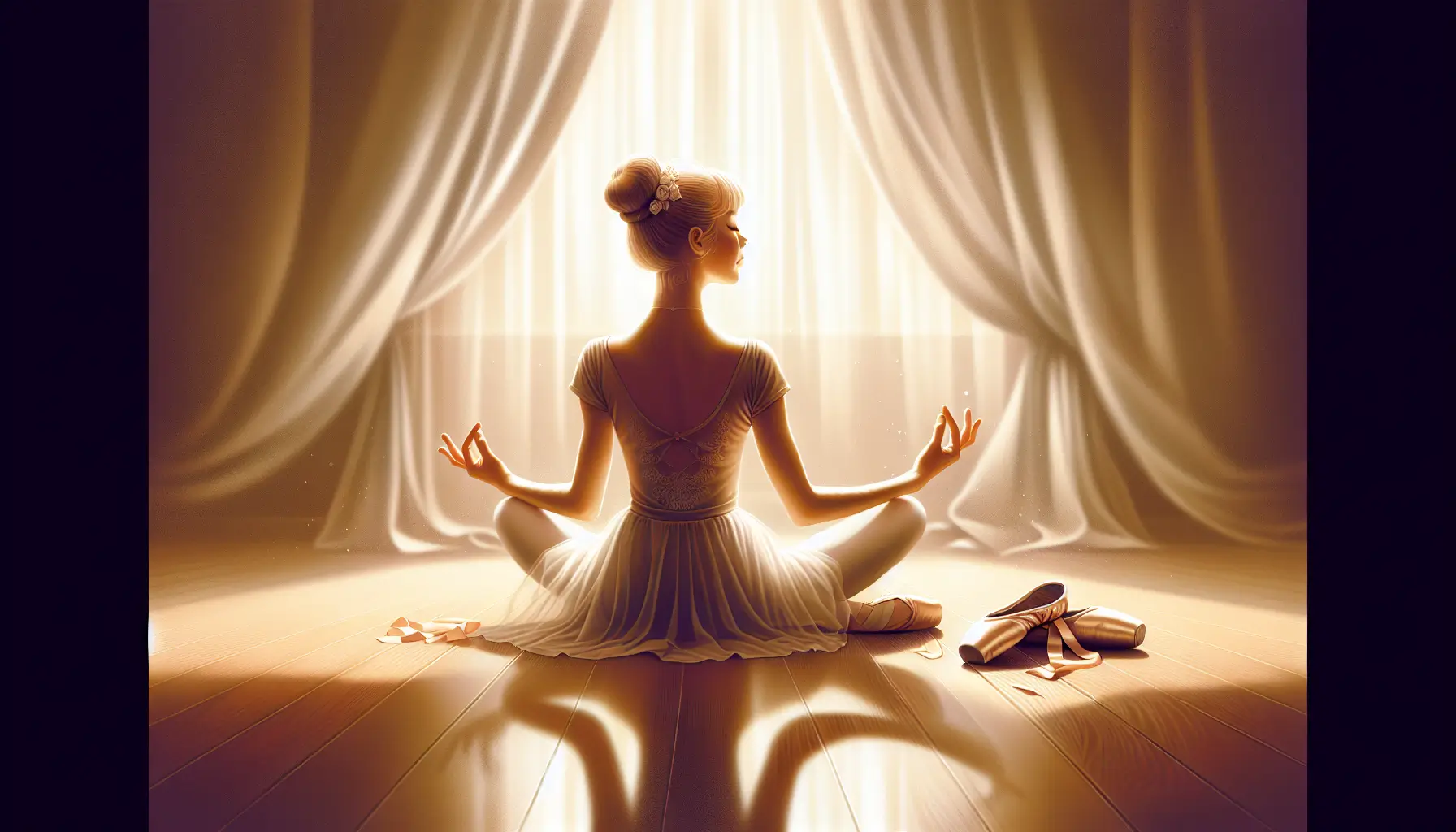How do you prepare for a ballet performance, whether you are part of a ballet company or an independent dancer? It’s not just about mastering your dance routine; preparation for ballet classes and performance encompasses rest, nutrition, mental readiness, and organization. This article provides actionable tips to help you excel in ballet class and feel confident on stage.
Graceful Insights
- Prioritizing rest and recovery is essential for dancers to prevent injuries and maintain peak performance.
- A balanced diet and proper hydration are crucial for sustaining energy levels and supporting muscle function in ballet dancers.
- Developing a consistent pre-performance routine, including warm-ups and mental preparation techniques, helps manage anxiety and enhances performance quality.
Preparation Podcast
| Tip | Description | Why It’s Important |
|---|---|---|
| Warm-Up and Stretching | Start with a proper warm-up to increase flexibility and prevent injuries. Focus on dynamic stretching and mobility. | Warming up ensures muscles are primed for movement, reducing the risk of strains and improving overall performance. |
| Consistent Rehearsal | Practice your routines consistently, focusing on the areas that are challenging for you. Break down each segment into manageable parts. | Rehearsal builds muscle memory, refines technique, and boosts confidence for the live performance. |
| Mental Visualization | Mentally rehearse your choreography and visualize yourself executing it perfectly. | Visualization helps reduce performance anxiety, increases focus, and prepares the mind for the movements that follow. |
| Proper Nutrition and Hydration | Eat a balanced diet with sufficient carbohydrates for energy and stay well-hydrated. Avoid heavy meals before performing. | Proper nutrition ensures sustained energy levels and optimal physical performance during ballet. |
| Strength and Conditioning | Incorporate cross-training exercises, such as Pilates or core work, to build strength, balance, and flexibility. | Strong muscles, particularly the core, improve ballet movements’ posture, balance, and control. |
| Focus on Recovery | Use foam rolling, stretching, and adequate rest to recover between rehearsals. | Recovery prevents muscle soreness and overuse injuries, keeping your body in top condition for performance. |
| Costume and Shoe Preparation | Ensure your costume fits well and your shoes are properly broken in. Pack extra supplies, such as tights or ribbons. | A well-prepared costume and properly fitted shoes prevent distractions and discomfort, allowing you to focus on dancing. |
| Mindfulness and Breathing | Practice deep breathing and mindfulness exercises to stay focused before stepping on stage. | Staying calm reduces nerves and helps you perform at your peak under pressure. |
| Final Run-Throughs | Run through your routine a few times in the performance space to get accustomed to it. | Familiarizing yourself with the space can help reduce stage fright and assist in adjusting to different stage dimensions or flooring. |
| Get Enough Sleep | Ensure you get quality sleep, especially the night before the performance, for optimal physical and mental alertness. | Sleep improves muscle recovery, memory retention, and mental clarity, leading to peak performance. |
Prioritize Rest and Recovery

Getting enough rest is one of the most vital yet often overlooked aspects of preparing for a ballet performance. Self-care and rest not only prevent burnout but also enhance overall performance. Recovery time allows muscle repair, helping dancers perform at their best without risking injury.
Rest days in your training schedule significantly contribute to consistent performance. Adequate rest prevents injuries and maintains overall health, making it essential in ballet training. Mental recovery is as important as physical rest. It rejuvenates your focus, ensuring you are mentally prepared to tackle the challenges of a demanding ballet routine.
Quality sleep is also crucial. It affects cognitive functions and reaction times during performances. Before a big day or big performance, rest your muscles, get adequate sleep, and allow time for muscle memory to solidify routines to ensure peak performance.
Nutrition and Hydration for Optimal Performance

A dancer’s body, like a well-maintained car, needs proper nutrition and hydration for optimal performance. Nutrition supports energy levels and overall performance. A balanced diet that includes carbohydrates, proteins, and healthy fats helps prevent injuries and keeps the body energized.
Hydration is also crucial to dancing. Water supports muscle function and recovery, vital during rigorous dance classes, practices, and performances. Staying well-hydrated, especially during intensive training and dancing, is key to a dancer’s pre-performance routine.
Balanced Diet for Dancers
Ballet dancers must eat a balanced diet to fuel their demanding routines, whether in classical ballet or modern dance. Inadequate calorie intake can lead to injuries and nutrient deficiencies, which are detrimental to a dancer’s career. Proteins, about 12-15% of a dancer’s diet, are vital for muscle building and repair.
Healthy fats provide sustained energy and promote muscle repair. Modern dancers should eat balanced meals and snacks rich in various nutrients to support intense training and achieve peak performance.
Importance of Hydration
Hydration is a cornerstone of maintaining peak physical condition for dancers. Dancers should aim to drink at least 3 liters of water a day, increasing their intake during extended dance periods.
A reusable water bottle can remind you to stay hydrated throughout the day. Proper hydration significantly impacts performance and recovery, making it an essential component of a dancer’s regimen.
Perfecting Your Pre-Performance Routine

The path to a flawless performance begins long before stepping onto the stage. Preparation and practice are fundamental for ballet companies and dancers to feel confident, perform well, and enjoy their performances. This involves mental and physical preparedness, not just rehearsals.
Young performers and seasoned dancers alike can benefit from fine-tuning their pre-performance routines. Developing a consistent warm-up and rehearsing pre-show rituals ensures mental and physical readiness.
Develop a Consistent Warm-Up
A well-planned warm-up prepares the body without causing muscle fatigue. Warm-up exercises and deep breathing techniques can calm nerves and increase oxygen supply to the brain.
Physical movements, such as running or stretching, help release nervous energy before a performance. These activities ensure your body is warm, flexible, and ready for peak performance.
Rehearse Your Pre-Show Rituals
A consistent pre-show routine reduces nervousness and enhances backstage enjoyment. These rituals create mental cues that prepare the body for optimal performance readiness, providing comfort and focus.
Rehearsing in the actual performance venue can reduce anxiety by familiarizing you with the space. Familiarity with the venue translates into increased confidence and a more relaxed performance.
Managing Pre-Performance Anxiety

Managing pre-performance anxiety is crucial in preparing for a ballet performance. Comprehensive preparation encompasses both mental readiness and physical health, encompassing not just rehearsals. Mental conditioning enhances focus and performance quality, which is essential in dancers’ preparation.
Recognizing and addressing specific triggers of performance anxiety, like fear of judgment and lack of preparation, can help combat pre-performance anxiety and stage fright. Effective strategies can significantly impact how a dancer feels and performs.
Techniques to Overcome Stage Fright
Stage fright commonly causes anxiety before performances. Practicing in a similar setting to the actual performance can reduce stress and increase comfort. Reflecting on past successful performances boosts confidence and helps overcome stage fright.
These techniques can significantly improve dancers’ ability to manage stage fright and perform their dances with confidence.
Mental Preparation Strategies
Visualization techniques, such as imagining a successful performance, boost male dancers’ confidence and mental readiness. Visualizing the performance environment, stage, choreographer, and audience helps dancers mentally prepare and reduce fear.
Mindfulness practices help performers stay focused and alleviate worries about potential mistakes. Reinterpreting stage fright as excitement or passion channels energy in a positive way, thereby enhancing the performance experience.
Building Confidence
Building confidence is crucial to a dancer’s journey, particularly when performing on stage. As a ballet dancer, developing a strong sense of self-assurance is critical in executing movements with precision and poise. One effective way to build confidence is through consistent practice and repetition. By rehearsing regularly, dancers can develop muscle memory and become more comfortable with their movements, allowing them to focus on expression and artistry.
Receiving constructive feedback from instructors and peers is another valuable way to build confidence. This feedback helps dancers identify areas for improvement and develop their strengths. Additionally, watching professional ballet performances and studying the techniques of experienced dancers can be incredibly inspiring and help build confidence.
It’s also important for dancers to focus on their strengths and weaknesses rather than comparing themselves to others. By acknowledging and embracing their unique qualities, dancers can develop a more positive self-image and perform with greater confidence. Remember, every ballet dancer has their journey, and celebrating your progress is key to building lasting confidence.
Organization and Planning
Effective organization and planning are key to a successful ballet performance. Recognizing triggers of performance anxiety and preparing accordingly can enhance confidence and mitigate anxiety during performances.
Checklists and schedules are integral to this preparation. A well-structured performance schedule reduces anxiety and enhances the ambiance of the dressing area.
Create a Performance Checklist
I am double-checking your dance bag for essentials before show day, which is crucial. A performance checklist should include tasks, reminders for nutritious snacks, music, pickup protocols, and audience behavior.
Placing small costume pieces in zip-lock bags and labeling them helps prevent the loss of items. Cleaning and using costumes, labeling all shoes before the performance, and having extra tights can be lifesavers in case of wardrobe malfunctions.
Schedule and Time Management
A performance schedule and choreography can help reduce pre-performance jitters and serve as a fun decorative element in the dressing room during rehearsals. A well-choreographed dance routine and a balanced rehearsal schedule prevent dancer burnout and promote effective training.
Including transport service contact information in the checklist streamlines logistics on the day of performance. Fun colored pens or highlighters can make the schedule more engaging and easier to follow.
Essential Ballet Training Tips

Excelling in ballet requires consistent practice and a variety of disciplines. Regular practice sessions enhance skills and performance. Balancing practice with adequate rest avoids burnout and self-doubt. Subscribing to resources like Dance Business Weekly can provide valuable insights and strategies for improving your dance business and training regimen.
Strong technique and flexibility are essential for ballet dancers, especially male dancers, in the corps de ballet. These elements are fundamental for male dancers to perform complex movements with grace and fluidity.
Regular Practice Sessions
Consistent practice is the backbone of a dancer’s training. Regular practice ensures dancers are well-prepared for their routines. Excessive rehearsal can lead to burnout, self-doubt, and injury, so striking a balance is crucial.
A proper warm-up increases blood flow and flexibility, crucial for injury prevention. Effective training should include classes in varied disciplines to complement ballet and enhance performance.
Focus on Technique and Flexibility
A strong technique is fundamental for performing complex movements with precision and elegance. Flexibility is essential for achieving a wider range of motion and executing movements smoothly.
Ballet requires balancing strength and flexibility to achieve grace and fluidity in movements, much like a ballet dancer has legs. This balance sets apart a good performance from a great one.
Performance Considerations
When it comes to performing on stage, there are several considerations that ballet dancers should keep in mind. One of the most important aspects is stage presence. This refers to the ability to command the audience’s attention and convey emotion through movement and expression. Developing a strong stage presence can significantly enhance the impact of your performance.
Another key consideration is the need to adapt to different performance environments. This may include adjusting to various stage sizes, lighting, and sound systems. By being flexible and adapting to new situations, dancers can ensure a successful performance regardless of the venue.
Additionally, dancers should be mindful of their physical and mental well-being before and during a performance. This includes getting plenty of rest, eating a balanced diet, and managing pre-performance anxiety. Techniques such as deep breathing, visualization, and mindfulness can help alleviate pre-performance anxiety and stage fright. By caring for their bodies and minds, dancers can perform at their best and deliver a memorable performance.
Classical Ballet Performance
Classical ballet is a highly technical and formal art form requiring years of training and dedication. It is characterized by its use of pointe shoes, tutus, and other traditional costumes, as well as its emphasis on technique and tradition. When performing classical ballet, dancers should focus on executing movements with precision and control. This includes paying attention to proper alignment, turnout, and movement quality.
In addition to technical precision, dancers should strive to convey emotion and tell a story through their movements. This adds depth and meaning to the performance, making it more engaging for the audience. Male dancers, in particular, play a crucial role in classical ballet performances. They are often required to perform complex lifts and partnering movements, which demand great strength and control. By mastering these skills, male dancers can add depth and nuance to a classical ballet performance.
The corps de ballet, or group of dancers who perform together in a ballet, is also an essential part of classical ballet performance. The corps de ballet can create a powerful and visually stunning performance by working together as a cohesive unit. Each dancer’s precision and synchronization contribute to the overall impact of the performance.
Overall, classical ballet performance is a highly demanding and rewarding art form that requires great skill, dedication, and artistry. By mastering the techniques and traditions of classical ballet, dancers can deliver a truly unforgettable performance that captivates and inspires their audience.
Enjoy the Moment
Amidst all the preparation and hard work, remember why you started dancing: the joy of performing and the dance spirit. Enjoying the experience during your after-school performance with dance friends can enhance the overall dance experience for ballet students and make all the effort worthwhile.
Having fun during rehearsal for a performance helps you connect with company members and the audience, conveying the emotion of the music and dance. Preparation boosts confidence and ensures you can fully enjoy the magical moments on stage.
Resume
Preparing for a ballet performance involves a holistic approach encompassing rest, nutrition, routine, anxiety management, organization, and training. Each element is critical in ensuring you step onto the stage as your best self.
Remember to appreciate the art form, the process, and the performance. The hard work, dedication, and passion you bring to your dance career, including ballet as a company member, and as a matter of fact, a dancer. Still, it will also create memorable performances and dances that you and your audience will cherish.
Frequently Asked Questions
Why is rest important for dancers?
Rest is fundamental for dancers, as it facilitates muscle repair, prevents injuries, and supports mental recovery —all vital for achieving peak performance. Prioritizing adequate rest will enhance overall dance effectiveness and longevity in the discipline.
What should a dancer’s diet include?
A dancer’s diet should balance carbohydrates, proteins, and healthy fats to maintain energy and facilitate muscle repair. Prioritizing these nutrients will enhance performance and recovery.
How can I manage pre-performance anxiety?
To effectively manage pre-performance anxiety, consider utilizing visualization techniques, mindfulness practices, and establishing consistent pre-show routines. These methods can help significantly calm your nerves and enhance your performance.
What should be included in a performance checklist?
A performance checklist should include essentials such as dance shoes, costumes, nutritious snacks, and contact information for transport services to ensure a smooth execution. Including these items will help the company members, choreographers, and participants stay prepared and focused.
How important is hydration for dancers?
Hydration is crucial for dancers, as it supports muscle function and facilitates recovery, which in turn significantly impacts overall performance and health. Staying properly hydrated is essential for maintaining optimal physical performance.







